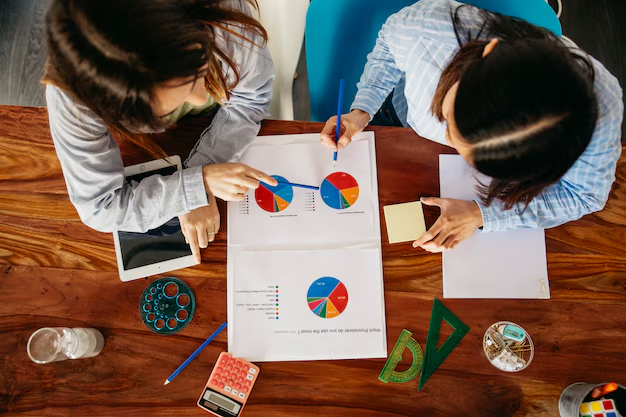Table of Contents
ToggleEconomic Education: Teaching students about money and the economy is key today. Educators and policymakers are looking for the best ways to do this. In this article, we’ll look at different ways to make economic education more effective. We want students to understand finances and the economy better.
Key Takeaways
- Countering stereotypes and addressing information gaps in economic and financial education is essential for creating inclusive and accessible learning environments.
- Providing relevant course content that connects economic concepts to meaningful, real-world settings can increase student engagement and understanding.
- Fostering open and critical discussions in the classroom, encouraging questioning and independent thinking, can foster critical analysis skills in students.
- Emphasizing communication and collaboration skills, including written and oral communication, can prepare students for effective economic and financial decision-making.
- Incorporating diverse and evidence-based teaching methods, such as active learning strategies, can create dynamic and impactful economics education programs.
Countering Stereotypes and Closing Information Gaps
Getting more students, especially from groups not well represented, to study economics needs some work. We can change the game by offering detailed info on economics so that students can make wise choices. This means explaining what they’ll learn and the ways they can use it.
Also Read : What Are The Options For Financing Post Secondary Education?
Providing Information About the Breadth of Economics
The world of economics is broad and full of different directions. There’s macroeconomics and microeconomics, or labor economics and development economics, which all offer unique paths. By reaching out and using online department websites and events, we can show off these paths. This way, students can see the variety of jobs waiting for them after they graduate.
Explaining the Learning Process and Academic Practices
For many students, how economics works can be a mystery. This is especially true for those who are the first in their family to go to college or don’t see a lot of others like them in school. We need to explain clearly about the tough courses and how professors are there to guide them. Plus, let them know about doing research or getting work experience while still in school. This makes the whole economics world much less scary and more welcoming.
Small steps like sending out helpful emails and sharing stories from other students can change a lot. They can help correct false ideas and fill in info gaps that students might have. This way, we can open the door to a wide range of students to check out the exciting field of economics.
Also Read : Engineering Education: What Skills Are Needed?
Offering Relevant Course Content for Diverse Students

To engage a diverse class, it’s key to choose course content that matches their real-life experiences. By linking economic ideas to things students care about, learning becomes more fun and inclusive. This approach helps students of all backgrounds realize the value of what they’re learning.
Connecting Concepts to Meaningful Settings
Instructors need to ditch boring or old examples. Instead, they should place economics into contexts that students find important. This might involve studying how money gaps affect local areas. Or, it could be about the impact of climate rules on various groups of people.
Replacing Trivial Examples with Consequential Applications
Many textbooks and lessons use dull or unimportant examples. These often miss the point of what’s happening in today’s world. Teachers should switch these out with lessons that matter. This way, students see how economics touches on big issues we face today.
By selecting relevant course content, teachers can better reach diverse students. They can show how economics is actually very relevant to what students care about. This changes a class from boring to enjoyable, all while teaching important lessons. Yet, it’s also important to show that economics isn’t perfect. Show that researchers are always working to make things better. This helps students see the world’s problems in a new light. It also gives them hope that big issues, like inequality and climate change, can be tackled.
Also Read : These 50 Photos Of Unique People Show That Genetics Is Hard To Forget
Diversifying Authorship and Topics
Adding more diverse authors and subjects to economic education is key. Many textbooks in economics don’t highlight the work of various groups. This means students miss out on different viewpoints. It’s vital to change the lack of variety in economic studies and articles. Most materials are by white men. This leads to a one-sided view of economic ideas and their applications.
This limits the rich insights diverse researchers could provide. Adding research and papers from women, minorities, and others can improve this. Also, we should teach more than just traditional economics. Topics like behavioral economics and the economics of race and gender are important. They make students think critically and open their minds to new ideas.
By making economic education more varied, we show the broad spectrum of human experience. This not only improves the curriculum but also creates a more open learning environment. Everyone, no matter their background, can be inspired to explore economics.
“Diversity in economics is not just about representation – it’s about expanding the range of perspectives and insights that can drive innovation and progress in the field.”
Also Read : How Does Technology Influence Medical Education?
Acknowledging and Improving Economic Models

It is key to know that economic models have limits. Economists are always working to make them better. This helps everyone understand the world and think deeply about economic ideas. Economic models are good for thinking and choosing but often not detailed enough about real life. Knowing this helps students look into the details, limits, and improvements of economic systems.
Letting students tell their own stories about things like unemployment and poverty makes them really understand how economic models fall short. This makes learning more engaging and helps students see the hard work of improving these models.
| Economic Model Limitation | Potential Improvement |
|---|---|
| Oversimplification of complex economic phenomena | Incorporating more nuanced and interdisciplinary approaches to capture the multifaceted nature of economic systems |
| Reliance on unrealistic assumptions (e.g., perfect information, rational behavior) | Integrating insights from behavioral economics and cognitive psychology to better reflect human decision-making |
| Failure to adequately consider the impact of institutional and political factors | Expanding the scope of economic models to include institutional dynamics and the role of policy interventions |
Recognizing these flaws and showing how we’re working to fix them is important. It helps students see the big picture and prepares them to think critically and contribute to economics.
“The true test of the value of a theory is not its elegance or simplicity, but its ability to accurately capture and explain the real-world phenomena it seeks to understand.”
Also Read : Financial Jobs: How Does Technology Impact The Field?
Fostering Open and Critical Discussions
It’s vital to have open, critical talks in class for better economic learning. By making economic ideas interesting to think about, teachers help students ask questions. Students then form their own opinions. This boosts their thinking skills and makes them grasp the boundaries of economic ideas better.
Presenting Content Critically
Teachers shouldn’t just tell students about the economy. They should make students think deeply by questioning common ideas. This action shows the good and bad parts of different economic views. The goal is to give students a full and rich understanding.
Encouraging Questioning and Independent Thinking
- Promote an environment where students feel comfortable voicing their questions and concerns about economic concepts.
- Encourage independent research and analysis, empowering students to explore economic issues from their own unique perspectives.
- Avoid presenting economic theories and models as absolute truths, but rather as tools for understanding complex realities.
- Facilitate discussions that challenge students to think critically about the underlying assumptions and implications of economic policies and practices.
Through open and critical talks, teachers aid students in mastering crucial thinking. They go beyond just learning models and theories. They become ready to face real economic challenges confidently and with deep insight.
“The most important thing in the teaching profession is to teach people to think, to question, and to participate in open discussions.” – Noam Chomsky
Emphasizing Communication and Collaboration Skills
Good communication and collaboration help economists a lot. Still, studies show we need to teach these skills better in economics. Letting students write for different people, like researchers, policymakers, and the public, is important. So is training students to talk well and debate. These changes could fix the lack of these skills in economics grads.
Practicing Written Communication for Various Audiences
Economists often talk to lots of different people about their work. This includes other economists as well as people who are not economists. Learning to explain difficult ideas in simple ways is key. It helps make economic concepts clear and builds trust in economists. This way, students can learn to write in a way that suits whoever reads their work.
Developing Oral Communication and Debate Skills
Talking well and debating well are must-haves for economists. They need these skills to show their work, discuss it, and stand by their ideas. By giving students the chance to speak publicly, answer questions, and join debates, we can help. This grows their ability to share economic analysis with many listeners, like lawmakers and people in general.
| Communication Skill | Importance for Economists | Benefits for Economics Education |
|---|---|---|
| Written Communication | It lets economists share complex ideas with everyone, from researchers to the public. | This skill helps students make economic ideas clear. It improves how well people understand and trust economists. |
| Oral Communication | It lets economists talk about their work, join talks, and stand for their beliefs. This is important for making their voices heard in decisions and public talks. | This helps students become more confident in talking in public. It means they can explain economic ideas well to many people. |
| Debate Skills | It helps economists have important discussions, challenge ideas, and offer new viewpoints. This makes economics a better field with more ideas. | This teaches students to think deeply, see things from different sides, and stand for what they believe. It helps with being creative and working well with others. |
Teaching good communication and collaboration in economics makes sense. It helps students prepare for dealing with many people and big problems in their jobs. In the end, this can make economics more liked and understood. It could increase how much people get involved and understand economics.
Also Read : Nursing Education: Why Choose A Science Degree?
Providing Real-World Practice Opportunities
Teaching about the economy isn’t just about lessons in the classroom. We must offer chances for students to use what they learn in the real world. By working with policymakers, business people, and others, students see how economic ideas work in real life.
One great way to do this is by setting up internships or projects with real companies, government bodies, or non-profits. This lets students share their economic ideas with different people. It’s a key skill for future success in economics.
- Collaborate with local policymakers to provide economic analysis and policy recommendations
- Partner with businesses or the private sector to consult on real-world economic challenges
- Engage with the general public through community outreach programs or economic education initiatives
These hands-on experiences improve how students communicate and work with others. They also show the value of economic knowledge in the working world. By connecting what’s taught in class to real life, students are better prepared for their careers.
| Practical Application | Intended Audience | Key Skill Development |
|---|---|---|
| Internships with government agencies | Policymakers | Communication, critical thinking, policy analysis |
| Consulting projects with private companies | Business professionals | Collaboration, problem-solving, data analysis |
| Community outreach programs | General public | Presentation, empathy, public engagement |
By offering these real-world chances, economic education improves and becomes more engaging. It better prepares students for jobs in the public and private sectors.
Economic education

Learning about how money works is very important. It gives students skills that help them in the real world. Teachers can do this by breaking stereotypes, talking about today’s issues, and using different teaching methods. This way, students learn how to deal with money and understand the world better.
One major part of this is financial literacy. It helps students know how to handle their economics own money. This means learning about budgets, saving, investing, and managing debt. By teaching these skills in school, students can make smart choices with their professional development money. This sets them up to do well in the future.
But, economic education is not just about personal money matters. It’s also about the center for economic education big picture of how the economy works. This means federal reserve bank learning about markets, trade, and the rules that governments set. By showing how financial education these things matter in real life, students can economics standards understand their own communities better.
Also Read : PHD Education: Can I Work During A PHD?
| Key Aspects of Effective Economic Education | Benefits for Students |
|---|---|
|
|
Using these approaches, economic education can be a economic and financial great students in grades programs in economics tool. It can turn students into smart money managers and informed citizens. Whether it’s about investment education, economic literacy entrepreneurship training, or key economic economic literacy principles, good economic education sets students up for success economic literacy in the new world.
“Economic education is not just about numbers and formulas; it’s about empowering individuals to make informed decisions that shape their financial futures and contribute to the broader economic landscape.”
Using Diverse and Relevant Teaching Methods
It’s not just what we teach, but how we teach that matters. Using a mix of relevant teaching methods can make learning more fun and welcoming. This is especially true council on economic Education for students who might not see themselves represented. It can help them do better in their studies and stay motivated.
Incorporating Active Learning and Evidence-Based Pedagogies
Active learning is a way for students to really get involved in lessons. It’s often better than the old way of just listening to lectures. By using methods like problem-solving in groups and working through real-life cases, students get a chance to really understand economic ideas.
This kind of teaching makes students think hard and develop ways to solve problems. It also makes learning more exciting for everyone. With these methods, teachers create classrooms that work for all kinds of students.
| Teaching Method | Description | Benefits |
|---|---|---|
| Problem-Based Learning | Students work in groups to solve real-world problems, applying economic concepts and principles. | Enhances critical thinking, problem-solving, and collaboration skills. |
| Case Studies | Students analyze and discuss in-depth business or policy case studies to understand economic issues. | Develops analytical and decision-making abilities, as well as communication skills. |
| Simulations | Students participate in interactive economic simulations, such as market simulations or policy decision-making scenarios. | Provides hands-on experience and a deeper understanding of economic principles in action. |
Using a mix of different teaching ways and proven methods makes learning better for everyone. It fits the different ways students like to learn. This includes students who might not always feel included in class discussions.
“Incorporating active learning and evidence-based teaching methods can significantly improve student engagement and academic performance, particularly for underrepresented groups in economics.”
Also Read: Education Degree Online: What Are The Admission Requirements?
Conclusion
It’s essential to teach students about the economy well. This empowers them with real-world and financial knowledge. A broad plan can make economic lessons more interesting. It also turns students into people who understand the economy.
To do this, teachers should break stereotypes and cover practical topics. They should encourage students to talk about topics openly and think critically. Also, teaching skills like how to work together is important. Different teaching styles should be used.
This approach helps students understand the economy better. It shows them how to use this knowledge in their lives. This way, they can handle the problems they meet and make their communities better.
Teaching the economy this way helps create a new kind of citizen. They are smart with money and understand how the economy works. These people can make good choices and help improve their community and country.
FAQs
Q: What is the Council for Economic Education (CEE)?
A: The Council for Economic Education is a non-profit organization dedicated to advancing economic and financial literacy through educational programs and resources for K-12 students and teachers.
Q: What are some upcoming programs offered by the Center for Economic Education?
A: The Center for Economic Education offers various upcoming programs focusing on professional development, classroom resources, and student programs related to economics and personal finance.
Q: How can professional development benefit K-12 teachers in economics education?
A: Professional development programs provide K-12 teachers with the necessary skills and knowledge to effectively teach economics and personal finance concepts in the classroom.
Q: What is the importance of financial literacy in K-12 education?
A: Financial literacy is crucial for K-12 students to develop essential skills in managing personal finances and making informed economic decisions throughout their lives.
Q: What are some resources available for K-12 teachers to teach economics and personal finance?
A: K-12 teachers can access classroom resources and professional development materials provided by organizations like the CEE and other economic education programs.
Q: How can educators participate in the Stock Market Game for teaching economics?
A: Educators can engage their students in the Stock Market Game to teach practical lessons in economics and personal finance by simulating stock market investment scenarios.
Q: What research opportunities exist in the field of economic education?
A: The field of economic education offers various research opportunities to explore effective teaching methods, student learning outcomes, and the impact of financial education programs.





